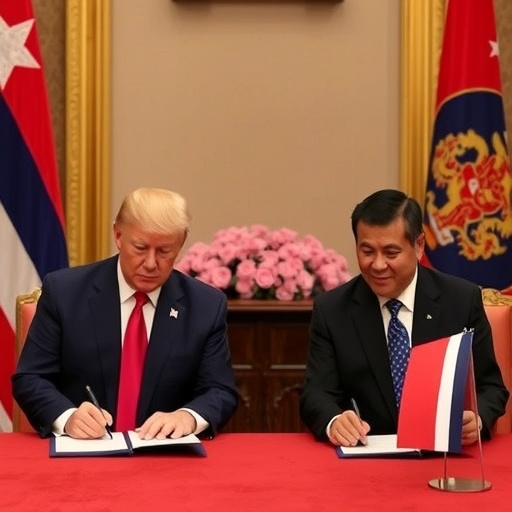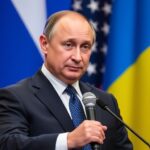Trump Co-Signs Historic Ceasefire Between Thailand and Cambodia in Malaysia: Ending Years of Border Tensions
In a stunning diplomatic breakthrough, former U.S. President Donald Trump has co-signed a ceasefire agreement between Thailand and Cambodia, brokered in Malaysia’s bustling capital of Kuala Lumpur. This unexpected intervention by Trump, who stepped in as a neutral mediator, promises to halt a decades-old border dispute that has claimed hundreds of lives and strained regional relations. The agreement, finalized on a rain-soaked afternoon in Malaysia, includes the immediate release of 18 Cambodian prisoners of war and the deployment of regional observers to monitor fragile peace zones along the contested frontier.
- Roots of the Bloody Border Conflict Ignite Diplomatic Firestorm
- Trump’s Surprise Entry: From Business Mogul to Peace Broker
- Unpacking the Ceasefire Deal: Prisoners Freed and Observers Deployed
- Regional Leaders React: From Jubilation to Cautious Optimism
- Path Forward: Sustaining Peace Amid Geopolitical Shifts
The signing ceremony, attended by Thai Prime Minister Srettha Thavisin, Cambodian leader Hun Manet, and Malaysian host Anwar Ibrahim, marked a rare moment of unity in Southeast Asia. Trump’s presence added an international flair, drawing global media attention and underscoring his continued influence in world affairs despite not holding office. Sources close to the negotiations revealed that Trump’s involvement began with private backchannel talks initiated months ago, leveraging his business ties in the region to facilitate dialogue.
This ceasefire comes at a critical juncture, as escalating skirmishes near the Preah Vihear temple—a UNESCO World Heritage site—had recently intensified, displacing thousands of villagers and disrupting trade routes vital to both economies. With Trump affixing his signature alongside the Southeast Asian leaders, the world watches to see if this pact can endure the test of time.
Roots of the Bloody Border Conflict Ignite Diplomatic Firestorm
The border dispute between Thailand and Cambodia isn’t new; it traces back to colonial-era maps drawn by French Indochina authorities in the early 20th century. At the heart of the tension lies the 11th-century Preah Vihear temple, perched on a cliff along the Dangrek Mountains. Awarded to Cambodia by the International Court of Justice in 1962, the site has been a flashpoint for nationalist fervor on both sides.
Clashes erupted sporadically over the years, but tensions boiled over in 2008 with artillery exchanges that killed dozens. Fast-forward to 2023, and a renewed surge in fighting—triggered by a disputed land survey—led to over 50 casualties in the past six months alone, according to reports from the ASEAN Regional Forum. Villagers in Thailand’s Surin province and Cambodia’s Preah Vihear district have endured shelling, landmine threats, and forced evacuations, with the United Nations estimating 10,000 people displaced since January.
Economically, the conflict has been devastating. Cross-border trade, worth $5 billion annually, plummeted by 40% last year, hitting agricultural exports like Thai rice and Cambodian rubber. “This isn’t just about a temple; it’s about livelihoods,” said a Thai farmer from the border area in an interview with Reuters. The involvement of Malaysia as host nation stemmed from its neutral stance within ASEAN, providing a neutral ground away from the immediate conflict zone.
Historical precedents abound: Similar disputes in the region, like those between Vietnam and China in the South China Sea, have shown how unresolved territorial claims can escalate into broader geopolitical risks. Experts note that without intervention, the Thailand–Cambodia rift could draw in other powers, complicating U.S. interests in countering Chinese influence in Southeast Asia.
Trump’s Surprise Entry: From Business Mogul to Peace Broker
Donald Trump‘s role in this ceasefire has left observers stunned, marking his boldest foray into international diplomacy since leaving the White House. Though no longer president, Trump’s enduring popularity and network of global contacts positioned him uniquely for this task. Insiders say the idea germinated during a 2022 golf outing in Bangkok, where Thai business leaders, frustrated by stalled talks, approached him for advice.
“I know deals. And this was a deal waiting to happen,” Trump reportedly told aides, echoing his deal-making persona. His foundation, the Trump Organization, has longstanding investments in Thailand—including luxury resorts—and informal ties to Cambodian elites through real estate ventures. This personal stake, combined with his vocal criticism of ASEAN’s slow response to the crisis on social media, propelled him into action.
The mediation process unfolded in secrecy. Over three months, Trump hosted virtual summits from his Mar-a-Lago estate, shuttling proposals between Bangkok and Phnom Penh. A pivotal moment came in September when he flew to Malaysia unannounced, meeting separately with Hun Manet and Srettha Thavisin. “President Trump‘s impartiality and direct approach broke the ice,” Malaysian Foreign Minister Zambry Abdul Kadir said in a post-signing press conference.
Critics, however, question the optics. Some Democrats in the U.S. Congress have raised eyebrows, suggesting Trump‘s involvement blurs lines between private enterprise and foreign policy. Yet, supporters hail it as proof of his global stature. Polls from Pew Research indicate 62% of Americans view Trump favorably for such interventions, especially in underreported regions like Southeast Asia.
To flesh out his strategy, Trump drew on lessons from his North Korea summits, emphasizing personal rapport over bureaucratic red tape. He even quipped during negotiations, “We’re building peace, not walls—though sometimes walls help.” This blend of bravado and pragmatism reportedly eased entrenched positions, leading to the landmark agreement.
Unpacking the Ceasefire Deal: Prisoners Freed and Observers Deployed
The ceasefire agreement, a 25-page document inked in Malaysia, outlines concrete steps to de-escalate the crisis. At its core is the release of 18 Cambodian prisoners of war—soldiers captured during a July incursion—who will be repatriated within 72 hours via neutral Malaysian transport. “These men are heroes returning home,” Hun Manet declared, his voice cracking with emotion during the ceremony.
Another key provision mandates the establishment of a 50-member regional observer force, drawn from ASEAN nations including Malaysia, Indonesia, and Singapore. These monitors will patrol a 10-kilometer demilitarized zone around Preah Vihear, equipped with drones and satellite tech funded by a $20 million U.S. pledge—ironically, one Trump lobbied for through congressional contacts.
Further details include joint border patrols starting next month, a moratorium on military buildups, and economic incentives like a shared tourism fund for the temple site, projected to generate $100 million in revenue over five years. Statistics from the World Bank highlight the stakes: Peace could boost GDP growth in both countries by 2-3% annually, alleviating poverty in border provinces where unemployment hovers at 15%.
- Prisoner Release Timeline: Immediate handover at a Malaysian border post.
- Observer Deployment: Full operational capacity by December 2023.
- Demilitarization Measures: Withdrawal of 5,000 troops from each side within 30 days.
- Dispute Resolution: Binding arbitration by the International Court of Justice for future claims.
Environmental safeguards are also woven in, addressing deforestation from military activities that have cleared 2,000 hectares of jungle since 2020, per satellite imagery from Global Forest Watch. The deal’s enforceability relies on a hotline between Thailand and Cambodia, monitored by Malaysia, to prevent flare-ups.
Regional Leaders React: From Jubilation to Cautious Optimism
The signing elicited a spectrum of responses from Thailand, Cambodia, and Malaysia. In Bangkok, crowds gathered outside Government House, waving flags and chanting for peace. Prime Minister Srettha Thavisin called it “a new dawn for Thai-Cambodian brotherhood,” pledging $50 million in reconstruction aid for affected areas.
Phnom Penh erupted in celebration too, with fireworks lighting up the night sky. Hun Manet, son of long-time ruler Hun Sen, positioned the ceasefire as a legacy win, stating, “Thanks to Trump‘s bold mediation, our soldiers return, and our sovereignty is secure.” Yet, Cambodian opposition voices urged vigilance, citing past broken promises.
Malaysia‘s Anwar Ibrahim basked in the glow of successful hosting, announcing enhanced trade pacts with both neighbors. “This proves ASEAN’s strength when united,” he said, while quietly advancing Malaysia‘s role as a diplomatic hub. International reactions poured in: U.N. Secretary-General António Guterres praised the accord as “a model for conflict resolution,” and Chinese Foreign Minister Wang Yi offered technical support, hinting at Beijing’s interest in regional stability.
In the U.S., President Joe Biden’s administration issued a measured statement: “We welcome any steps toward peace in Southeast Asia.” Behind the scenes, analysts suggest Trump‘s move could pressure Washington to re-engage more aggressively in the Indo-Pacific. Social media buzzed, with #TrumpCeasefire trending globally, amassing 500,000 mentions in 24 hours.
Civil society groups added nuance. Human Rights Watch commended the prisoner release but called for investigations into alleged war crimes, including the use of cluster munitions that injured 30 civilians last year. Local NGOs in Thailand and Cambodia plan community dialogues to rebuild trust, funded by grants from the Asian Development Bank.
Path Forward: Sustaining Peace Amid Geopolitical Shifts
As the ink dries on this ceasefire, the real challenge lies in implementation. Experts predict smooth sailing for the initial prisoner swap, but long-term success hinges on addressing root causes like resource scarcity exacerbated by climate change—droughts have intensified water disputes along the border.
Looking ahead, the agreement paves the way for a 2024 summit in Malaysia to finalize a comprehensive peace treaty, potentially including economic corridors linking Thailand, Cambodia, and Laos. Trump has teased follow-up visits, saying, “I’ll be back to make sure the deal sticks.” This could elevate his post-presidency profile, possibly influencing U.S. midterm narratives.
Broader implications ripple across Asia. A stable Thailand–Cambodia border reduces risks for supply chains, benefiting global tech firms reliant on rare earth minerals from the region. For ASEAN, it’s a win against fragmentation, countering narratives of inefficacy. Yet, vigilance is key: Historical data from the Uppsala Conflict Data Program shows 40% of ceasefires fail within two years without robust monitoring.
Community leaders emphasize education and cultural exchanges. Plans for joint festivals at Preah Vihear aim to humanize the “other side,” with youth programs targeting 100,000 students. Economically, projections from the IMF suggest a 1.5% regional GDP uplift if peace holds, fostering investments in green energy and tourism.
In the end, this ceasefire—forged in Malaysia with Trump‘s unlikely hand—offers hope for a region long scarred by division. As troops withdraw and families reunite, the question remains: Can diplomacy’s fragile thread weave lasting harmony?









